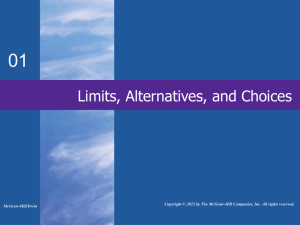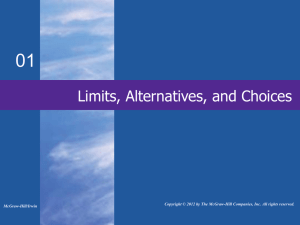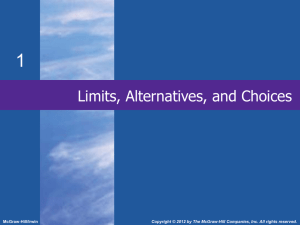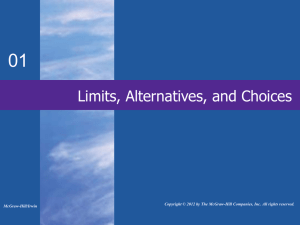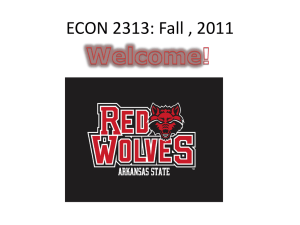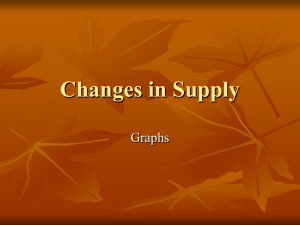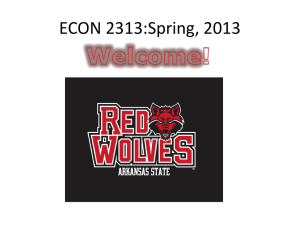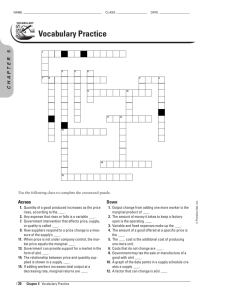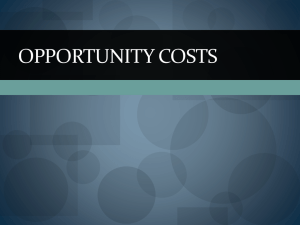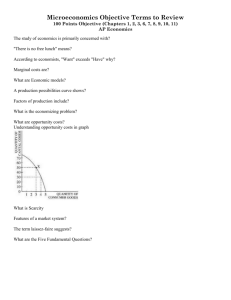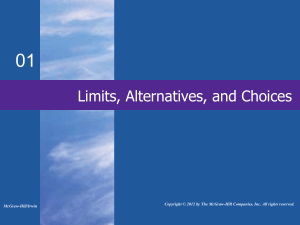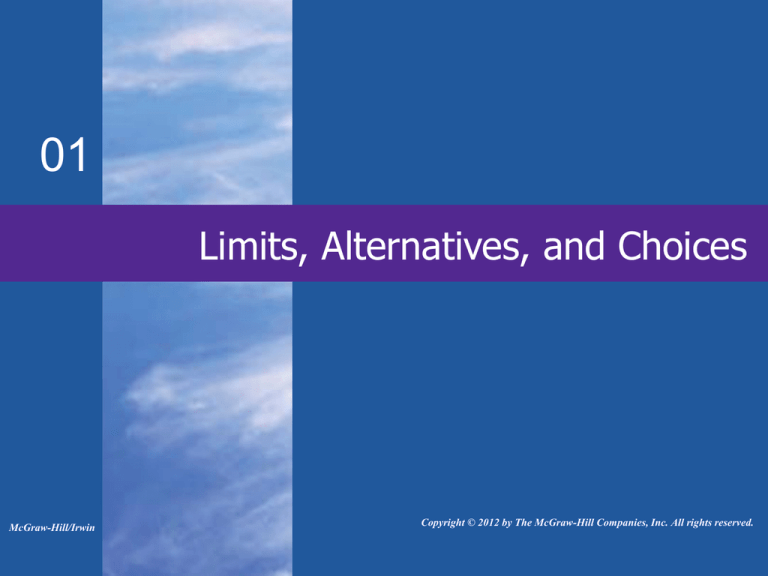
01
Limits, Alternatives, and Choices
McGraw-Hill/Irwin
Copyright © 2012 by The McGraw-Hill Companies, Inc. All rights reserved.
Introduction
•
LO1
Economics defined:
•
Economic wants exceed
productive capacity.
•
A social science concerned
with making optimal choices
under conditions of scarcity.
1-2
The Economic Perspective
•
•
Thinking like an economist
Key features:
•
•
•
LO1
Scarcity and choice
Purposeful behavior
Marginal analysis
1-3
Scarcity and Choice
•
•
•
Resources are scarce
Choices must be made
Opportunity cost
•
LO1
There’s no free lunch
1-4
Purposeful Behavior
•
•
•
•
LO1
Rational self-interest
Individuals and utility
Firms and profit
Desired outcomes
1-5
Marginal Analysis
•
•
•
•
LO1
Marginal benefit
Marginal cost
Marginal means “extra”
Comparison between marginal
benefit and marginal cost
1-6
Theories, Principles, and Models
•
The scientific method:
Observe
Formulate a hypothesis
Test the hypothesis
Accept, reject, or modify the hypothesis
Continue to test the hypothesis, if necessary
•
Economic principles
•
•
•
LO2
Generalizations
Other-things-equal assumption
Graphical expression
1-7
Microeconomics and Macroeconomics
•
Microeconomics
•
•
Macroeconomics
•
LO3
Decision making by individual
units
Aggregate
1-8
Positive and Normative Economics
•
Positive economics
•
•
Normative economics
•
LO3
Deals with economic facts
A subjective perspective of
the economy
1-9
Individual’s Economizing Problem
•
•
•
Limited income
Unlimited wants
A budget line
•
•
•
•
LO4
Attainable and unattainable options
Tradeoffs and opportunity costs
Make the best choice possible
Change in income
1-10
Individual’s Economizing Problem
12
DVDs Books
$20
$10
10
6
5
4
3
2
1
0
0
2
4
6
8
10
12
Quantity of DVDs
$120 Budget
Income = $120
=6
Pdvd = $20
8
Unattainable
6
Income = $120
= 12
Pb = $10
4
2
0
Attainable
2
4
6
8
10
12
Quantity of Paperback Books
LO4
14
1-11
Global Perspective
LO4
1-12
Society’s Economizing Problem
•
Scarce resources
•
•
•
•
LO4
Land
Labor
Capital
Entrepreneurial Ability
1-13
Society’s Economizing Problem
• Entrepreneurial ability
• Takes initiative
• Makes decisions
• Innovates
• Takes risk
LO4
1-14
Production Possibilities Model
•
•
Illustrates production choices
Assumptions:
•
•
•
•
LO5
Full employment
Fixed resources
Fixed technology
Two goods
1-15
Production Possibilities Table
Production Alternatives
Type of Product
Pizzas
A
B
C
D
E
0
1
2
3
4
10
9
7
4
0
(in hundred thousands)
Industrial Robots
(in thousands)
Plot the Points to Create the Graph…
LO5
1-16
Industrial Robots
Production Possibilities Curve
14
13
12
11
10
9
8
7
6
5
4
3
2
1
The law of
increasing
opportunity
costs makes
the PPC
concave.
A
B
Unattainable
C
D
U
Attainable
E
0
1
2
3
4
5
6
7
8 9
Pizzas
LO5
1-17
Marginal Benefit & Marginal Cost
Optimal Allocation
MC
15
a
c
MB = MC
e
10
5
b
d
MB
0
1
LO5
2
Quantity of Pizza
3
1-18
A Growing Economy
•
Economic Growth
•
•
•
LO6
More resources
Improved resource quality
Technological advances
1-19
A Growing Economy
Production Alternatives
Type of Product
Pizzas
A'
B'
C'
D'
E'
0
2
4
6
8
14
12
9
5
0
(in hundred thousands)
Industrial Robots
(in thousands)
LO6
1-20
Industrial Robots
A Growing Economy
A’
14
13
12
11
10
9
8
7
6
5
4
3
2
1
B’
Unattainable
A
Economic
Growth
C’
B
C
D’
D
Now Attainable
Attainable
E’
E
0
1
2
3
4
5
6
7
8 9
Pizzas
LO6
1-21
Future
Curve
Current
Curve
P
Goods for the Present
Presentville
LO6
Goods for the Future
Goods for the Future
Present Choices, Future Possibilities
Future
Curve
F
Current
Curve
Goods for the Present
Futureville
1-22
International Trade
• Specialization
• Increased production possibilities
LO6
1-23
Pitfalls to Sound Economic Reasoning
• Biases
• Loaded terminology
• Fallacy of composition
• Post hoc fallacy
• Correlation not causation
1-24

